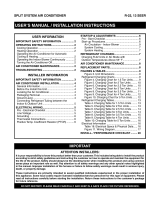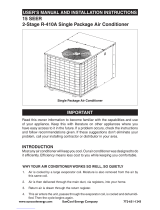
7
ELECTRICAL CONNECTIONS
1. ELECTRICAL SERVICE
High Voltage
a. Install a branch circuit disconnect of adequate size per
NEC. Locate the disconnect within sight of the unit.
b. Extend leads through power wiring hole provided. Connect
L1 and L2 directly to the contactor. (See Figure 8).
c. Ground the air conditioning unit using the green grounding
screw provided in the control panel.
Low Voltage
a. Route 24v control wires through the sealing grommet near
the power entrance.
b. Connect the control wires to the leads in the low voltage
area. (See Figure 9).
2. OVERCURRENT PROTECTION
In general, the best fuse or breaker for any air conditioner is
the smallest size that will permit the equipment to run under
normal use and service without nuisance trips. Such a
device, sized properly, gives maximum equipment protection.
The principal reason for specifying a time delay type is to
prevent nuisance trips when the unit starts.
Figure 8. Power Entry
High Voltage
Low Voltage
In the event that a fuse does blow or a breaker trips, always
determine the reason. Do not arbitrarily put in a larger fuse or
breaker and do not, in any case, exceed the maximum size
listed on the data label of the unit.
3. LOCATING THE THERMOSTAT
Locate the thermostat away from drafts and slamming doors
and place it where there is a free flow of air. Mount on an inside
wall approximately five feet from the floor.
Do not locate near a lamp, kitchen range, direct sunlight, or in
line with air flow from supply registers.
a. Connect Cooling Thermostat: The cooling thermostat
available for use with this system is equipped with a
selector switch. To shut down the air conditioner, set the
selector switch to the OFF position. Connect the red and
yellow wires from the unit to the R and Y terminals
respectively on the thermostat subbase. Connect the
green wire to the yellow wire at the unit. See the instruction
sheet packed with the thermostat for detailed methods of
mounting.
NOTE: The cooling-only thermostat must be connected
to an interlock switch to prevent simultaneous operation
of the furnace and the air conditioner. (See Figure 1,
Page 1.)
b. Connect the Heat-Cool Thermostat: The heat-cool
thermostat is equipped with a system HEAT-COOL
switch, which provides a positive means of preventing
simultaneous operation of the heating and cooling units.
The thermostat is also equipped with an ON-AUTO fan
switch which allows the home owner to operate the indoor
blower when air circulation is desired.
Connect the red, yellow, green and brown low voltage
wires to the R or RC, Y, G and W terminals respectively
on the thermostat base. The black wire is the 24 volt
common required on some thermostats. See thermostat
instruction sheet for more detailed information.
Refer to furnace installation instructions for required
connections and proper heat anticipator setting when
installing unit with an external furnace.
Figure 7. Drain Trap
Elbow
P-Trap
WARNING:
Turn off electrical power before servicing
controls. Severe electrical shock may result
unless power is turned off. Unit must be installed
in compliance with the National Electrical Code
(NEC) and local codes.
!
!
CONDENSATE DRAIN
A 3/4" condensate fitting extends out of the side of the unit.
The drain trap, shipped in the electrical compartment, must be
installed to prevent water from collecting inside the unit.
Thread the elbow provided with the unit into the drain connection
until hand tight. Install the trap into the fitting and seal the
joint. Make sure it is level. Route the condensate from the trap
to a suitable drain. Any connecting tubing or hose must have
the outlet below the trap level for proper drainage.














